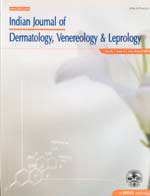
|
Indian Journal of Dermatology, Venereology and Leprology
Medknow Publications on behalf of The Indian Association of Dermatologists, Venereologists and Leprologists (IADVL)
ISSN: 0378-6323
EISSN: 0378-6323
Vol. 73, No. 5, 2007, pp. 313-318
|
 Bioline Code: dv07117
Bioline Code: dv07117
Full paper language: English
Document type: Research Article
Document available free of charge
|
|
|
Indian Journal of Dermatology, Venereology and Leprology, Vol. 73, No. 5, 2007, pp. 313-318
| en |
Patch testing experience with 1000 patients
Bajaj, AK; Saraswat, Abir; Mukhija, Gaurav; Rastogi, Shashank & Yadav, Sudha
Abstract
Background: Patch testing is a definitive tool for diagnosing allergic contact dermatitis (ACD). It reveals the prevalence and trends of contact sensitization in the community, thereby paving the way for better standard series. There is paucity of large series of patch-tested patients from India.
Aim: To report the 9-year patch-test data from a single general dermatology centre in North India.
Methods: Consecutive patients presenting with signs/symptoms of suspected ACD were patch tested from May 1997 to April 2006. The Indian Standard Series was used. Parthenium was tested only in selected patients and cetrimide and chloroxylenol were added to the series.
Results: In total, records of 1000 patients (566 male, 434 female) were analyzed, yielding 1155 positive reactions in 590 (59%) patients. Footwear dermatitis was the commonest suspected diagnosis, followed by ACD to medicaments, cosmetic dermatitis and plant dermatitis. Out of the allergens that were tested in all the patients, positivity to nickel was the commonest (12.9%), followed by potassium dichromate (11.1%) neomycin (7%), mercaptobenzthiazole (6.6%), nitrofurazone (6%), colophony (5.7%), fragrance mix (5.5%) and cobalt chloride (5.4%). However, parthenium was the commonest allergen based on the proportion of patients tested with it (14.5%). In men, potassium dichromate (30%) was the commonest sensitizer and in women, nickel (43%) was the commonest to show patch-test positivity.
Conclusion: Our study revealed higher prevalence of footwear and medicament dermatitis in comparison to existing data. Allergy to antiseptics is significant in our patients. Further collaborative studies involving patients from other parts of India are required to have an overall view of ACD in India.
Keywords
Allergic contact dermatitis, Chromate, Dermatitis medicamentosa, Footwear dermatitis, Nickel, Parthenium, Patch testing
|
| |
© Copyright 2007 Indian Journal of Dermatology, Venereology and Leprology.
Alternative site location: http://www.ijdvl.com
|
|
